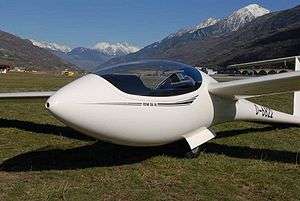Schleicher ASW 28
The ASW 28 is a Standard Class glider with a fifteen-metre span built of modern fibre reinforced composites. The manufacturer of the ASW-28 is Alexander Schleicher GmbH & Co. The 'W' indicates this is a design of the influential and prolific German designer Gerhard Waibel. Serial production started in 2000.
| ASW 28 | |
|---|---|
 | |
| ASW 28-18 | |
| Role | Standard-class sailplane |
| National origin | Germany |
| Manufacturer | Schleicher |
| Designer | Gerhard Waibel |
| First flight | ca. 2000 |
| Number built | >144 |
| External image | |
|---|---|
Design and development
The ASW 28 is a single-seat shoulder-winged composite construction sailplane with a T-shaped horizontal tailplane and 15 metre wingspan. The upper wing surface has Schempp-Hirth brake flaps.
As all Standard Class sailplanes, the ASW-28 does not have flaps or other lift-enhancing devices. It has tall winglets, a retractable undercarriage and a water ballast system. The structure is a complex composite of carbon, aramid and polyethylene fibre reinforced plastic. This permits a light structure with the strength to carry large amounts of water ballast, thus permitting the widest possible range of wing loadings for weak and strong soaring weather.
The ASW-28 supersedes the ASW 24 in the manufacturer's production line. It has – like its competitors Rolladen-Schneider LS8 and Schempp-Hirth Discus-2 – a version with wing extensions for the increasingly popular 18 metre Class, the ASW 28-18. The sustainer (non-self-launching) variant of the 18 metre version is the ASW 28-18 E. The sustainer uses a SOLO 2350 18 hp two-stroke engine.
Variants
- ASW 28
- Production variant with 15 metre wingspan.
- ASW 28-18
- Production variant with either a 15 metre or 18 metre span, also optional engine installation.
- ASW 28-18 E
- Production variant with a 13.2 kW (18 hp) SOLO 2350 2-stroke sustainer engine.
Specifications (with 15 metre wings)
General characteristics
- Crew: One
- Capacity: 200 kg (440 lb) water ballast
- Length: 6.59 m (21 ft 7 in)
- Wingspan: 15 m (49 ft 3 in)
- Height: 1.30 m (4 ft 3 in)
- Wing area: 10.5 m2 (113 sq ft)
- Aspect ratio: 21.4
- Airfoil: DU 99-147 and DU 99-125
- Empty weight: 240 kg (528 lb)
- Gross weight: 525 kg (1,155 lb)
- Powerplant: 1 × SOLO 2350 (ASW-28-18E only) , 13 kW (18 hp)
Performance
- Maximum speed: 270 km/h (170 mph, 150 kn)
- Maximum glide ratio: 45
- Rate of sink: 0.56 m/s (110 ft/min)
See also
Aircraft of comparable role, configuration and era
Related lists
References
| Wikimedia Commons has media related to ASW 28. |
- Alexander Schleicher GmbH & Co
- Sailplane Directory
- Simons M, Segelflugzeuge 1965–2000, Eqip, 2004